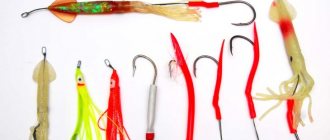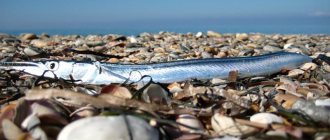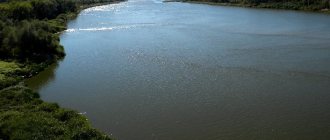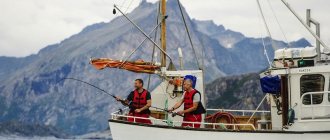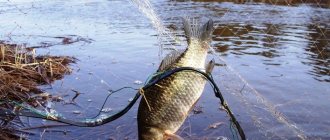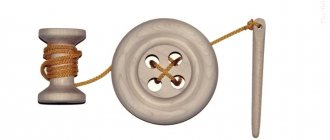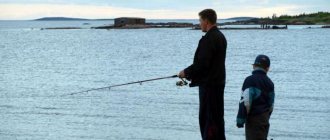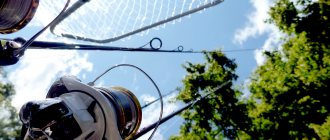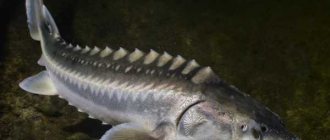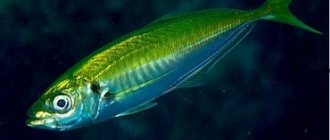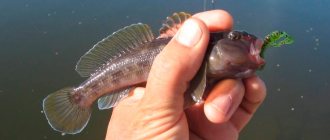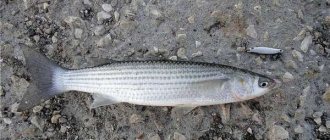Fishing on the White Sea
Only users with a rating above 20 can see the voting results (who voted and how).
Good afternoon. Finally, I decided to write a short report about our last fishing trip to the White Sea.
The road itself from the Tver region did not present any special surprises, but upon arrival we discovered that our intended departure point was covered with ice and launching boats was not possible.
A little upset, we began to look for a way out, which appeared before us in the form of UAZ cars in which local guys threw us with our things several tens of kilometers to clean water.
We collected the boats, went down to the still calm water and hit the road. Ahead of us lay almost 60 km of travel to an island with a familiar hut. The White Sea with floating ice floes greeted us with torrential rain and waves, but as they say, there was nowhere to retreat.
Rocks and frozen waterfalls floating by did not let our mood drop, and the words from the “Varyag” song heard over the water, performed by us, lifted our spirits and scared away curious seals.
I will not describe all our adventures in the next days, so as not to bore you. Several of them can be highlighted: the ice that came from the sea and cut us off from deep water for several days and an unsuccessful photo shoot, as a result of which our canon lies at a depth of 30m. It was this circumstance that influenced the quality and different sizes of the photos presented here.
A few words about gear and fishing methods. They fished mainly with jigs and jigs from boats and rocks. For the main “stick” I used a short Daiwa Team Daiwa MH spinning rod, a Ryobi Kriger 3000 reel and a 0.19 cord from Power pro. There was a greater variety of baits, which depended on the fishing location.
Fishing from the rocks seemed less convenient, but only until I decided to take foam with me.
The depth under these stones was small, about 15m. At first we tried fishing with a heavy jig, but there weren’t many bites.
Most of the bites occurred during the fall. Therefore, I decided to try small oscillating spoons. In the arsenal there was a small iron Evo-RG from Kosadaka in the size of 55m. Due to its shape, when falling, the spoon deviated from the trajectory and perhaps this provoked the cod to bite. I didn’t use leashes, for which I paid for it later.
I also tried a heavy kastmastet from the Acme company. The result was good, but again, due to the rapid fall of the bait, the bite became worse.
The Kosadaka MLx 55mm spinner also performed well from the rocks. But after a couple of fish, it was bitten off by some monster, I blame the catfish. In general, I noticed that the fish took spoons with a “edge” on the hook more willingly.
The cod pleased us not only with its bite, but also with its appearance. Depending on the fishing location, specimens of different colors were found. The color varied from dark green to pale yellow and even reddish. And of course, the ubiquitous “bulls” did not let us get bored.
A few words about the people and rules of the White Sea. On most islands there are houses with stoves and a supply of food that you can use if you get into trouble. But if you have the opportunity to update this stock, please do not skimp, maybe it will help someone. Still, mutual assistance in the “north” is not just words.
By the way, among the houses there are real masterpieces, but these are more than an exception to the rule.
Since it was the very beginning of the season, our only competitors were locals
Fishing from a boat is more effective. They are caught on a jig with shrimp or sand bait. Plumb or cast. Here the leader for me was the tires from Lucky John S-Shad Tail in the “machine oil” color and Kosadaka Xtech lure “Extreme edition” in the “Tr” color. The “Lucky John” rubber, apparently due to its similarity to sandblasters, was better, but it was enough for 5 or 6 bites, after which it turned into rags. Kosadaka's flavored rubber survived these tests without any problems.
Most of the small specimens were released, and we only took fish “for the pot.” In general terms, the bite was good and, if desired, it was possible to “fill in” quite a bit, but we were primarily interested in just relaxing
Heading North! Cod fishing in the White Sea. Part 3
Early in the morning, Sasha came up to our tent and asked: “Guys, are you going to catch cod or relax. " Fatigue suddenly disappeared, Vadim and I jumped out of the tent and began to get ready to hunt cod in the sea. Frankly speaking, I had a hard time believing in the success of this event, because yesterday’s hunt for White Sea herring ended in complete defeat.
We started the engine and at low engine speeds we set off along the navigator track to the promising banks. According to Alexander, the cod hold on the raised granite ridges, which are often covered with dense thickets of kelp.
The first rafting over a promising place... Vadim gets a vague bite, the spinning rod immediately takes the shape of a parabola and his partner begins to pump out the caught trophy. The first trophy was a bull.
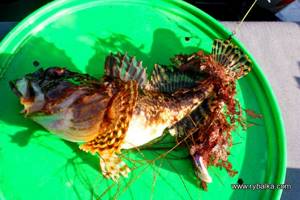
The gear for catching cod turned out to be exactly the same as for catching pike perch. I used my powerful Varita test range up to 45g, Shimano Ultegra 4000 reel, SunLine Super Braid 5 #1.5 diameter line, 28-35g jigheads and 3-4" vibrator tails. The bait in these conditions should imitate the usual target of cod hunting - White Sea herring. The most catchy rippers are considered to be white-blue, white-brown, that is, colors that, in our conditions, consistently shoot well at pike on the Desna River and its oxbow lakes. The bait is not completely attached to the jig head, only partially so that most of it hangs freely and is more mobile during the game.
The second approach is over the bank, the depth under the boat is about 6-7 meters and Vadim gets a bite again! The comrade begins to win the trophy. The water in the White Sea is as clear as a tear, so the entire path of the trophy, from the lowest point to the side of the boat, is easily visible. At first it seemed that the caught cod was unusually large, but... the closer the hooked fish came to the boat, the smaller it became in size. And so the first White Sea cod was brought on board. An unusually beautiful fish that sparkled in the rays of the rising sun with dark brown and burgundy tints. A start.
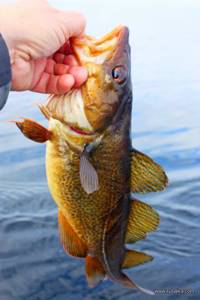
During our fishing trip we managed to catch some excellent fish. On one of the promising banks, only small cod weighing about 1 kg of dark brown color was caught. Bites in this place occurred with enviable regularity, but the farthest bank, the depth above which was about 7-8 meters, presented us with real trophies.
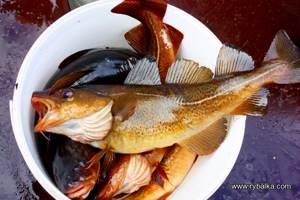
Soon luck smiled on me too. The next pass over the bank gave me a confident, powerful bite; after hooking, the fish moved from side to side and an enchanting dance began under water. Soon I managed to take my first cod on board! She was gorgeous and extraordinarily beautiful!
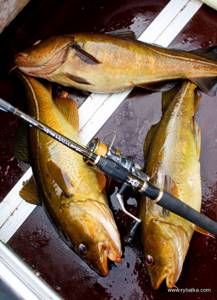
We decided not to experiment any more with fishing spots, but to focus on the bank, which brought really large fish. It’s noteworthy that vertical cod fishing somehow didn’t work out for me, so I caught it by casting on a pelagic jig. The bites are powerful, confident, exactly the same as those of a pike perch! This kind of fishing was very interesting and exciting.
The only problem when fishing for cod is getting caught on the powerful stalks of seaweed. During our fishing in these underwater thickets, we left a significant part of our fishing arsenal.
Local fishermen are armed with powerful Leningrad spinning rods with Neva reels and fishing line with a diameter of 0.6 -0.8 mm. With such equipment, you can easily pull out a kelp bush and lift it on board. When fresh, seaweed does not have a special taste; it gives off a lot of iodine.
The fishing somehow ended unexpectedly. Suddenly a strong side wind blew, multidirectional undercurrents formed in the sea and the bite instantly stopped. We go ashore and begin processing the caught trophies.
We only had a few hours left to stay in this place, so we wanted to try everything from the caught fish at once. Part of the team began preparing cod fish soup...
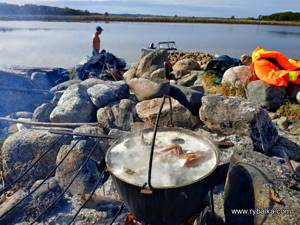
Vadim began to bake flounder and herring on the grill...
I wanted to try the legendary cod liver dish, but... we abandoned this idea. The whole liver was wormy, so we decided not to risk it, because there was plenty of food on the island.
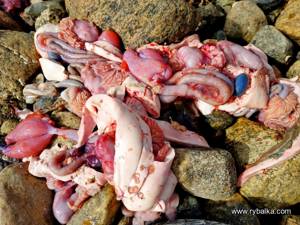
The fresh fish dishes turned out to be very tasty, it was difficult to tear yourself away from the meal...
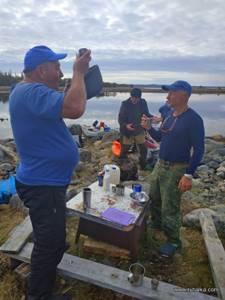
In the afternoon we jumped into the boats and headed for Solovetsky Island, towards civilization. It was a pity to say goodbye to such a wonderful place, but... no less interesting and exciting adventures await us.
Heading North! Catching smelt and herring in the White Sea. Part 5
Early in the morning we had breakfast, cleaned ourselves up and went to the yard to prepare gear for herring fishing. If on the islands we used rigging inserts that Vadim brought from Norway, then at the moment the rigging was already knitted from what was left. A heavy oscillating spoon was attached to the lower end of the fishing line, 4-5 silver hooks were placed above it on short leashes, and a plate from a beer can was tied at the top to further attract herring. The entire insert was tied to a powerful Favorite Varita 15-45 g rod, which was equipped with a 4000 Shimano Ultegra reel and SunLine Super Braid 5 # 1.5 line. Frankly speaking, it was difficult for me to believe that nowadays fish can be caught with bare hooks.
White Sea herring fishing takes place in one of the bays where ships and barges moor. To do this, we moved away from the shore by boat and stood slightly to the side of the shipping lane. The tackle swings in short jerks at the bottom, the spoons sparkle, attracting fish, and the herring attacks the hooks, which, as I was told, remind them of amphipods.
At the first point, things didn't go well for us. We swung the rigs for a long time, but there were no bites. I had already begun to lose interest in this event and believe that fish must be caught with full-fledged bait or lure... As in second place, Vadim got a daring bite and the tackle swung from side to side. I caught a small smelt. As soon as she was pulled out of the water, the resinous sea air was immediately filled with a pleasant cucumber aroma. A start!
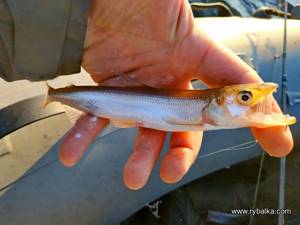
After catching the first fish, seagulls immediately came to us in the hope of a handout from the fishermen. The birds were placed near the boat, some of them could be reached with your hand.
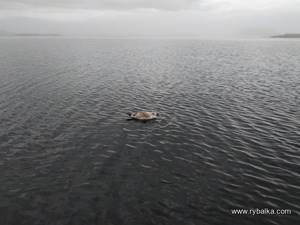
Soon the tackle began to convulsively beat on me, and I immediately began to fish it out. I also caught smelt. This was the first smelt in my life. Very beautiful fish!

And then a powerful distribution began. White sea herring was regularly caught on the starboard side, and quite large smelt were caught on our side with Vadim.
A little later, the herring approached our side. Carrying several plump herrings onto a spinning tackle is aerobatics. Sea fish are very strong and give off heat while fishing! Initially, after a bite, we immediately pulled out the tackle and caught one herring at a time, and later we switched to a more productive method: after biting and hooking one fish, the tackle is swung until all the hooks have herrings hanging on them. A White Sea fish caught on a hook, with its bustle, additionally attracts a school of fish and keeps it under the boat.
The weather at sea is changeable, the sun was shining in the morning, and in the evening a foggy drizzle fell into the bay and clouded everything around. It became chilly and cold.
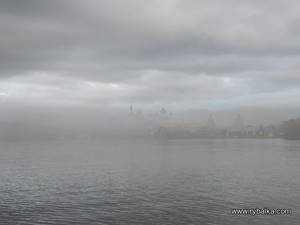
Fishing proceeded at a busy pace: smelt and herring were biting regularly all day. There were also some very heavy herrings, exactly the same as those sold at the market.
The fishing turned out to be very bright and eventful! In the evening we had a sumptuous dinner: fried herring, fried smelt, smoked flounder and... Yura prepared a local dish from small white sea fish - “mochko”. Small herring is placed on sliced onions, belly up, salted, peppered, poured with oil and after lightly frying, the whole fish is filled with water and in this state sits on low heat for about 10 minutes. Surprisingly, it turned out very tasty and elegant! This dish is so called because after the herring is eaten, an aromatic and tasty fish remains in the frying pan, which is soaked in bread crumb.
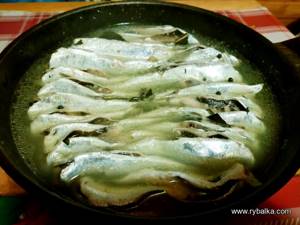
After dinner, we decided to go to rest earlier, because tomorrow we were planning a long trip into the depths of Karelia. To do this, you will need to cross the White Sea again and land on the mainland, travel several hundred kilometers and get to a beautiful lake. We will live in a hut for five days, catch pike and perch on the lake, in a word, the fishing adventure continues...
To be continued…
Cod fishing on the White Sea
Fishing on the White Sea differs from fishing in other seas or reservoirs, this is due to climatic conditions.
The main features of fishing on the White Sea:
- Cold water, even in summer.
- The maximum water surface temperature in the hottest month does not exceed 18 degrees Celsius.
- Complex bottom topography, as well as highly pronounced ebbs and flows.
- Frequent changes in wind direction.
- Mostly cold gusts of wind are observed, often stormy.
- The average wave height is 2-3 meters.
- The need to use several types of bait, including artificial ones.
- The probability of catching a large cod is minimal.
- The weight of such an individual varies from 750 to 950 grams.
- Possibility of successful biting around the clock and even in bad weather conditions.
For an untrained fisherman, fishing is quite difficult the first few times, so it is better to take an experienced person with you.
Where to look for cod in the White Sea?
Due to the relief features of the White Sea, as well as its depth differences, the distribution of cod in different areas is not the same.
You need to look for such fish depending on several factors:
- Season: in winter and until the end of spring - mainly at depth or in straits, and also where there is movement of warm currents.
- all summer and early September - it is better to look for nearby coasts;
- closer to mid-autumn and before the beginning of winter - mainly near rocks or in crevices.
- if fishing is done from the shore, then you need to choose places near the rocks;
- depths from 5 to 10 meters are most successful for fishing in the warm season;
Interesting fact: June and July are the months in which the greatest bite is observed, but the fish caught are on average about 30 centimeters long.
Among experienced fishermen, it is believed that the most successful place is an area rising 2-3 meters above the sea surface.
Tackle for catching flounder
Since this fish leads an exclusively bottom lifestyle , accordingly, flounder fishing is carried out with bottom gear. For this, powerful rods are best suited - carp or feeder rods, with a length of at least 3.9 meters, and preferably even longer.
The best choice would be a special saltwater fishing rod that has the necessary power and a protective coating against corrosive sea salt. Test rods should be chosen from 150 grams and above, since heavy weights should be used - which stick well to the seabed.
The rod should be equipped with a powerful spinning reel with a spool size of at least 5000, which can accommodate at least 150–200 meters of fishing line with a diameter of 0.35–0.4 mm. It is better to use monofilament fishing line; using a cord is not advisable, as it can rub against the rocky seabed.
gear for catching flounder in advance, since on most fishing trips there is a loss of sinkers or hooks, so it is advisable to have a certain supply of them, which is wound on the reel.
Everything you need can be purchased in the store, but equipment for catching flounder made by yourself is of great value.
To make gear you will need:
- the required number of 1.5 meter pieces of fishing line of the same diameter as the main fishing line;
- the required number of hooks No. 6–8 or 10 , depending on the size of the intended prey. Hooks must have a long shank, since flounder swallows bait deeply and in order to get a small hook, it is sometimes necessary to cut the fish;
- fishing line for leashes is taken with a diameter of 0.2-0.25 mm;
- flounder loves colored baits , so you need to have a pea-sized supply of red and green beads;
- a set of weights from 70–80 to 200 grams. Different fishing conditions may require different weights of different designs. The larger the wave or the sea current, the mass of the cargo should accordingly be greater;
- To quickly change gear, it is best to use powerful carabiners, which can be used to fasten both the tackle and the sinker.
Read about fishing with bottom tackle with a feeder in this article
And in the reviews of anglers about the FisherGoMan self-cutting fishing rod
To make the equipment, leashes 10–15 cm long are prepared, to which hooks are tied, and beads are placed on top of the hooks - one red and one green. The beads are fixed with a stopper. Leashes in the amount of 3 pieces are tied onto the rig at intervals of 20-30 cm, and carabiners are tied at the ends: one for the load, and the other for attaching to the main fishing line.
Then the finished product can be carefully wound on the reel and the next one can be made. In order to be fully equipped, it is better to make at least 10 gear, but with the increase in the planned scale of future fishing, their number will naturally increase proportionally. We also suggest that you watch this video about equipment for catching flounder.
When to catch cod on the White Sea?
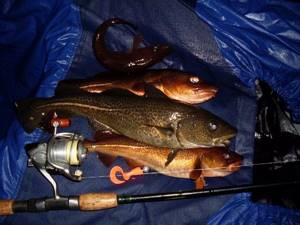
On the White Sea, cod fishing is guaranteed in any season, each has key features and distinctive points:
- Fishing in winter and spring: the possibility of biting the heaviest individuals;
- most often you come across a fish of about 900 grams, this is considered large in size for the White Sea;
- maximum predominance of cod at depth or in underwater crevices;
- It bites best on a combination of organic and artificial baits.
- cod is small in size, approximately 40 centimeters and weighing 700-800 grams;
Knowledgeable fishermen claim that on the White Sea the most fruitful periods for biting are as follows:
- from late April to mid-May - especially near the coast;
- from the first days of June to mid-October - at a distance of 150-200 meters from the shore.
Interesting fact: the bite is lowest during the period when there is a rise in cold waters from the depths, so it is advisable to refuse fishing on these days.
Fishing technique and tactics
Sea fishing requires the fisherman to have certain technical skills and a competent choice of tactics.
- The easiest way in this regard is for donkeys. It is enough to bait the hooks with tasty bait and set the equipment away from the shore. But even in this case, it is necessary to understand what the cod is feeding on at this moment. If there is no bite, you need to make adjustments to the fishing distance and experiment with baits.
- Sheer fishing involves rhythmically twitching the spoon in a vertical plane. The amplitude of vibrations at the bottom is 0.5-1.0 m.
After hooking, the predator behaves quite aggressively. The fish walks in circles, trying to go to cover. And if she rarely manages to leave the vessel when fishing, then problems often arise with the beavers. Large stones in the coastal zone become the predator's assistant in the fight against the fisherman. In this case, even the most durable gear turns out to be powerless to cope with cod.
The meat of freshly caught fish has an exquisite taste. Many fishermen consider it a delicacy, so they overcome many obstacles and difficulties to catch trophy cod.
Fishing from a boat or from the shore?
Fishing can be done quite successfully both from the shore and from a boat. Basically, experienced fishermen prefer to fish on motor boats; this makes it possible, in case of low bite in one area, to move to another area.
On the White Sea, fishing from boats has some characteristic features:
- it is necessary to move away from the shore by more than 200 meters, this allows you to not depend on the tides;
- it is required to use fishing lines exclusively with a diameter of 0.5-0.7 millimeters;
- you need to give preference to fishing gear and choose hooks made of brass;
- with the arrival of cold weather, be sure to move closer to the stone ridges, and in warm weather, choose an area near the rocks;
- move to a depth of at least 10-12 meters and where there is a strong current.
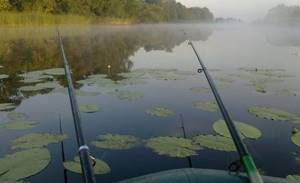
Many fishermen note that fishing for cod from the shore will bring more expected results, especially from the end of May to mid-August, the main thing is:
- fish during high tide;
- change bait as often as possible;
- cast with several fishing rods, preferably long in size;
- be located next to rocks;
- choose the time for fishing from 6-7 am until noon.
Tackle for cod fishing on the White Sea
Successful fishing directly depends on correctly selected gear. In general, it is possible to fish with various options of float rods, spinning rods and other things.
When choosing gear, there are several points to consider:
- Buy a medium-sized rod , but very durable, which can withstand many casts.
- The ideal length of a spinning rod for cod is from 1.8 to 2 meters.
- The weight of the tackle should be heavy , otherwise there will be difficulties when pulling out cod.
- It is better to take a multiplier reel designed for sea fishing, otherwise after the first contact with water it will rust and will be unsuitable for further use.
- In the summer, it is more advisable to abandon bottom tackle in favor of a short spinning rod or feeder.
- When fishing with a spinning rod, you need to have a large amount of different bait with you, since with this type of gear there is a risk of losing or breaking the bait.
- Use the equipment as simple as possible , a fairly reliable fishing line and hook.
In the White Sea it will not be possible to catch a trophy specimen, even if you use the latest and improved gear
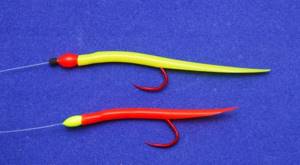
The daily diet of cod consists of small fish or shellfish, so when choosing a bait option, you must take this factor into account.
It bites well on many natural baits, especially:
- medium and large sized sea worms;
- pieces of herring;
- capelin;
- small sea bass;
- shrimp;
- shellfish
Advice: the main thing is that any bait is fresh, so you should look for it before you start fishing.
It is allowed to fish with artificial baits, sometimes the bite on them is not inferior to most natural ones, but you should only choose bright and shiny colors, preferably with many threads.
You can make spinners yourself - for them it is better to use red or white colors and a tee No. 12-14.
How to catch more fish?
Cod fishing
Cod fishing in the White Sea is a very exciting activity. The cod of the subspecies GadllS morhua marisalbi lives in the White Sea; it differs from its Atlantic relative in its smaller size. Its length is generally 60 cm, but on average, specimens of more modest sizes are caught.
Cod also varies seasonally. There is “summer” cod, which is smaller, and there is “winter” cod, which is larger in size.
Such winter cod approaches the coast at the end of August or beginning of September. The diet of cod includes smaller fish, primarily herring and sand lance, as well as bottom mollusks and various worms.
A large concentration of cod is noted in the Kandalaksha Bay (this is where the most productive cod fishing in the White Sea), but in shallow bays such as Onega and Dvina, cod is rare.
In summer and early autumn, cod are mainly found close to the shore. To get large specimens, you should look for them near rocks that go vertically into the sea, where there are sharp drops in the depths. Small cod are best caught off the rocky shore in shallow waters.
You should know that cod does not like silted and heavily foamed bays, as well as sandy beaches. As for the open sea, cod there prefers to be near rock ridges, which are covered by sea bottom vegetation. Such banks, as a rule, rise above the rest of the bottom topography. On the Coast of North Karelia, such places are called baklyshi or corgi.
In appearance, such areas look like a boulder that rises several meters above the water. It has no vegetation, and the depths there can reach 30 meters or more with fairly sharp drops.
Where the drop is steepest, cod fishing will usually be most effective. Cod also chooses places for parking where there are various rocky formations in places where coastal cliffs continue or in underwater crevices.
Such places are easily identified visually if you carefully study the coastline. This is, as a rule, a sheer rock, which is cut through by a crack and continues under water with a depth of 15-25 meters.
Of course, cod can also be found at much greater depths. Cod also loves the straits between the islands, where there is a fairly strong tidal current.
At the beginning of May, cod fishing begins, which often comes close to the shores when the sea opens up from ice. But soon, in the bays that cut deep into the land, cod bite for a long time. This is probably due to the fact that in such places the water is desalinated from melting ice for a long time.
Then the cod bite becomes active in early June and lasts almost until mid-October. In summer, there are also pauses in the bite, which are associated with the rise of cold water from the bottom of the sea.
Along with this rise, the migration of food organisms occurs. Shrimp, mollusks and others follow, followed by cod.
Also, cod during the mating of sea worms (nenreis), at this time cod fishing in the White Sea is carried out not with bottom gear, but with wire gear.
Local residents catch cod from boats using fairly simple gear consisting of thick fishing line with a diameter of 0.5-0.7 mm, reeling it on a reel. The role of the load is played by a fairly heavy spoon or a tube with a hook, white or made of brass.
The weight of such spinners is about 60-70 g. It is also possible to simply use a regular lead weight. In addition, tackle with a spinner may have leashes with a single hook.
In the Loaded Option, such leashes are mandatory. Fishing with such equipment is called “finger fishing”.
A cod bite is felt by the hand as a “blow”. Typically, anglers use a sandworm worm as a bait, which they extract with shovels at low tide. Since sea worms cannot survive for long outside their habitat, it is recommended before each fishing trip.
Alternatively, Nereis can be used to catch cod. When the breeding season of this worm begins, it comes to the surface of the water and is quite easy to catch.
Metal cats are used to pull out seaweed bushes from the water, in the roots of which they collect the Nereis sea worm. In addition, fishing for cod in the White Sea can also be done using bait such as pieces of capelin, herring, and chicken.
However, they cannot be compared with the first two baits in terms of effectiveness.
Features of cod fishing General information Cod has several varieties: Pacific, Baltic, White Sea, which have a characteristic white stripe on the side and a noticeable mustache under the lower lip. An adult fish reaches a meter to one and a half meters in length and weighs about 40 kg.
Flounder is not a very fastidious fish in terms of choosing bait, so catching flounder in Primorye may not be much different from hunting for it in the Black Sea.
Any sea mollusks that live in a particular region, shrimp, pieces of crab or squid, chopped fresh fish, sea worm - Nereis and many others can be used as bait. Moreover, the necessary bait can be obtained directly at the fishing site.
Fans of spinning fishing can try to catch flounder using artificial baits - weighted spoons - jigs, sinking wobblers and others. If you have a boat, you can catch flounder with a vertical lure.
Then there is no need for a long rod with a large test. Sea spinning brings great pleasure. True, in strong waves it is very difficult to catch flounder using a spinning rod.
Fishing tactics
For a fruitful bite, it is important to maintain a clear sequence in fishing, otherwise, even the presence of a large number of individuals in the sea will not bring the planned result.
Fishing tactics include several stages:
- Throwing the tackle to the maximum possible distance, the most optimal is considered to be from 14 to 25 meters.
- It is better to cast in several places at once, especially when fishing from the shore.
- Pulling donkeys, spinning rods and other things a short distance towards the boat or shore.
- Lowering the bait to the very bottom, then making 5-6 light but quick strikes to attract fish.
- Raising the bait approximately 40-50 centimeters from the bottom surface.
- If the bait is left on the bottom, the cod may not notice it.
- Periodically perform gentle twitching of the tackle, optimally at intervals of 10-15 minutes.
- Confident fishing immediately after the bite and further sharp hooking.
Interesting fact: the cod bite is sudden, so any relaxation during fishing will lead to the fish breaking off.
It is easier to carry out hooking together, in this case the chance of not missing the prey is much higher. In any case, even in the absence of bites, it is necessary to constantly monitor the presence of bait. Cod has a unique ability to unnoticed by the fisherman to pull any bait off the hook.
Advice: it is better to check the presence of bait every 30-40 minutes.
Fishing methods
To catch cod in the White or Baltic Sea, you need a reliable watercraft. The vessel must be equipped with a powerful motor and navigation system. To understand what gear is needed for cod, let’s consider the methods of catching it:
- You can catch cod from the shore using a spinning rod, but more often it is caught as bycatch. This usually happens during high tide.
- In some regions, successful fishing occurs with bottom gear when a school of cod approaches a distance of 20-40 m from the shore.
- Plunge fishing for cod is the most common method of catching fish. To do this, the boat or boat anchors in a promising place. Then the vertical movement of the bait begins at the very bottom. It is useful to attach pieces of fresh fish to the hook of an artificial spoon.
- You can catch trophy fish using sea trolling. The boat moves slowly so that the lure goes close to the bottom. Some anglers successfully use the drift of the vessel by performing a herringbone pattern.
Blitz tips:
- any equipment used must be durable; select equipment only suitable for fishing in salt water;
- It is more advisable to first catch a small sea bass or capelin and then use them as bait;
- if there is no bite, try casting with artificial bait;
- when hooking fish, any relaxation should be excluded;
- in winter it is better to use shellfish or worms as bait;
- Be sure to take warm clothes with you due to the unpredictability of the weather.
